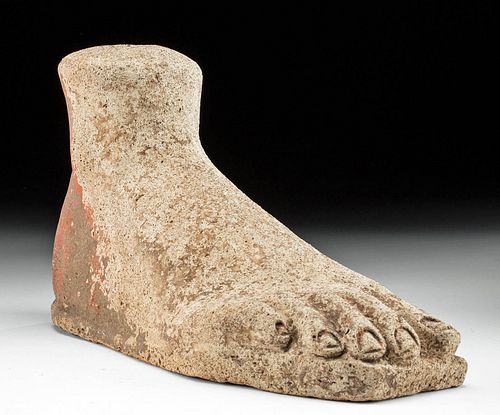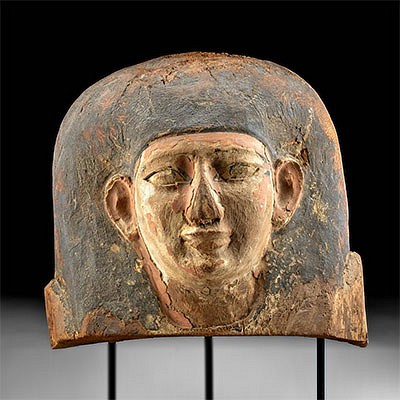Roman Terracotta Right Foot Votive
Lot 35d
About Seller
Artemis Fine Arts
686 S Taylor Ave, Ste 106
Louisville, CO 80027
United States
Selling antiquities, ancient and ethnographic art online since 1993, Artemis Gallery specializes in Classical Antiquities (Egyptian, Greek, Roman, Near Eastern), Asian, Pre-Columbian, African / Tribal / Oceanographic art. Our extensive inventory includes pottery, stone, metal, wood, glass and textil...Read more
Categories
Estimate:
$1,000 - $1,500
Absentee vs Live bid
Two ways to bid:
- Leave a max absentee bid and the platform will bid on your behalf up to your maximum bid during the live auction.
- Bid live during the auction and your bids will be submitted real-time to the auctioneer.
Bid Increments
| Price | Bid Increment |
|---|---|
| $0 | $25 |
| $300 | $50 |
| $1,000 | $100 |
| $2,000 | $250 |
| $5,000 | $500 |
| $10,000 | $1,000 |
| $20,000 | $2,500 |
| $50,000 | $5,000 |
| $100,000 | $10,000 |
| $200,000 | $20,000 |
About Auction
By Artemis Fine Arts
Aug 27, 2020
Set Reminder
2020-08-27 10:00:00
2020-08-27 10:00:00
America/New_York
Bidsquare
Bidsquare : VARIETY SALE | Antiquities & Ethnographic Art
https://www.bidsquare.com/auctions/artemis-gallery/variety-sale-antiquities-ethnographic-art-5477
Around the world & back in time - be amazed at the treasures you will find. Antiquities from Egypt, Greece, Italy and the Near East, Asian, Pre-Columbian, African / Tribal / Oceanic, Native American, Spanish Colonial, Russian Icons, Fine Art, much more! Artemis Fine Arts info@artemisfinearts.com
Around the world & back in time - be amazed at the treasures you will find. Antiquities from Egypt, Greece, Italy and the Near East, Asian, Pre-Columbian, African / Tribal / Oceanic, Native American, Spanish Colonial, Russian Icons, Fine Art, much more! Artemis Fine Arts info@artemisfinearts.com
- Lot Description
Roman, Imperial Period, ca. 1st to 3rd century CE. A hollow-molded right foot, not a section of a larger sculpture but a complete piece. This foot was at one time coated with red glaze, and large areas of the heel and toes have pigmentation. This is a life-size rendering of a foot and the toenails are prominently formed. Idealized shapes of feet were developed in Greek sculpture and was copied by Romans. Having an index toe longer than the big toe was the aesthetic foot shape that persisted in many Greco-Roman inspired sculpture. This is a wonderful votive of a ceramic foot! Size: 10.25" L x 3.375" W x 5.875" H (26 cm x 8.6 cm x 14.9 cm)
Roman and other ancient Mediterranean cultures, had a long-standing tradition of offering terracotta votives of everyday objects, animals, human figures like babies, and body parts at sanctuaries. Besides heads, hands and the feet were the most commonly offered votives since they were often injured in labor intensive societies. Local artisans created an industry to make and sell these offerings, producing pottery, such as this foot, and bronze models for supplicants.
Provenance: private East Coast, USA collection; ex-William Froelich collection, New York, USA, acquired in the 1970s
All items legal to buy/sell under U.S. Statute covering cultural patrimony Code 2600, CHAPTER 14, and are guaranteed to be as described or your money back.
A Certificate of Authenticity will accompany all winning bids.
We ship worldwide and handle all shipping in-house for your convenience.
#157506Loss to bottom edge. Surface wear, nicks, and abrasions commensurate with age. Earthen encrustations and remains of red glaze!Condition
- Shipping Info
-
All shipping is handled in-house for your convenience. Your invoice from Artemis Gallery will include shipping calculation instructions. If in doubt, please inquire BEFORE bidding for estimated shipping costs for individual items.
-
- Buyer's Premium



 EUR
EUR CAD
CAD AUD
AUD GBP
GBP MXN
MXN HKD
HKD CNY
CNY MYR
MYR SEK
SEK SGD
SGD CHF
CHF THB
THB
















